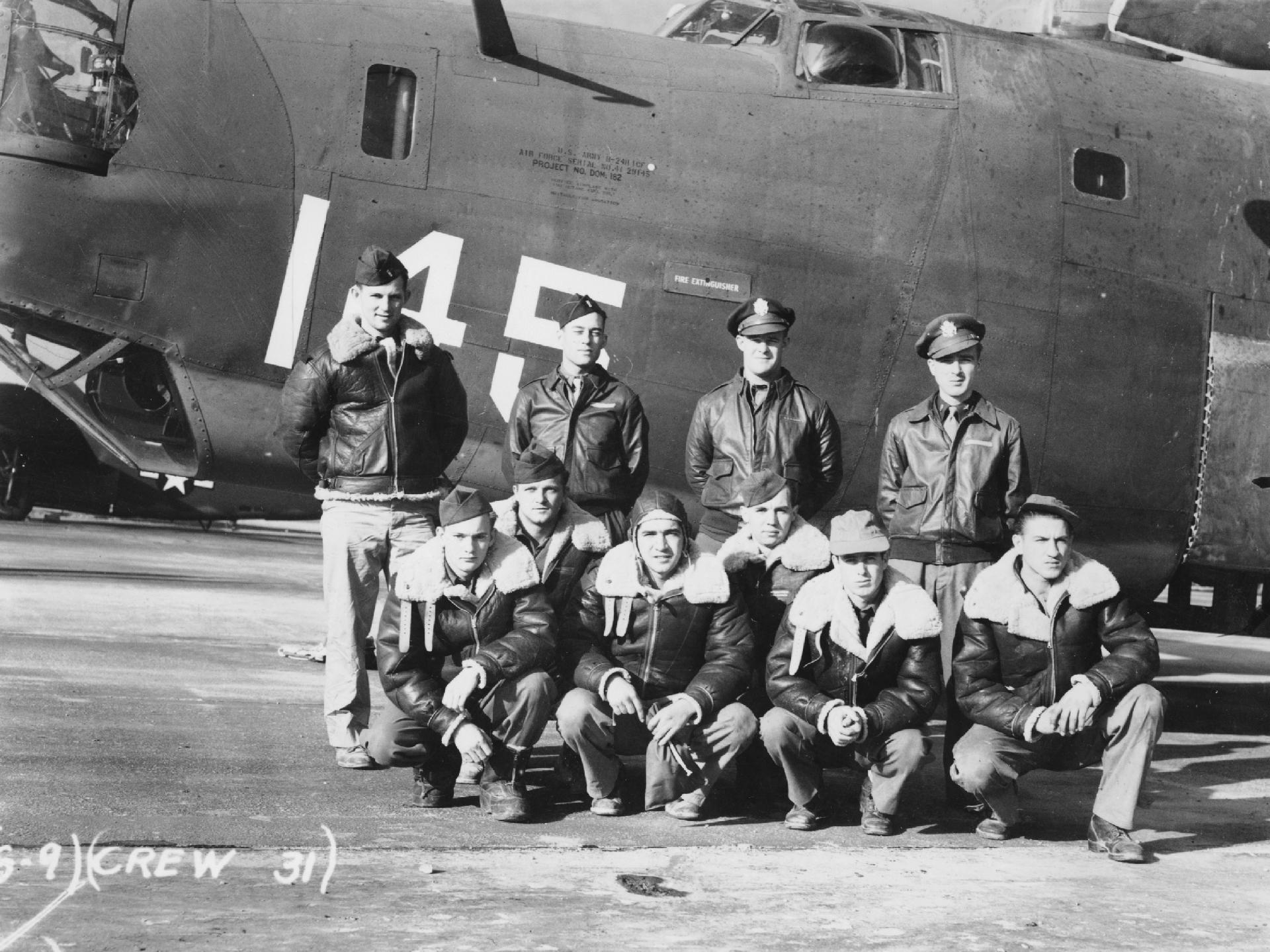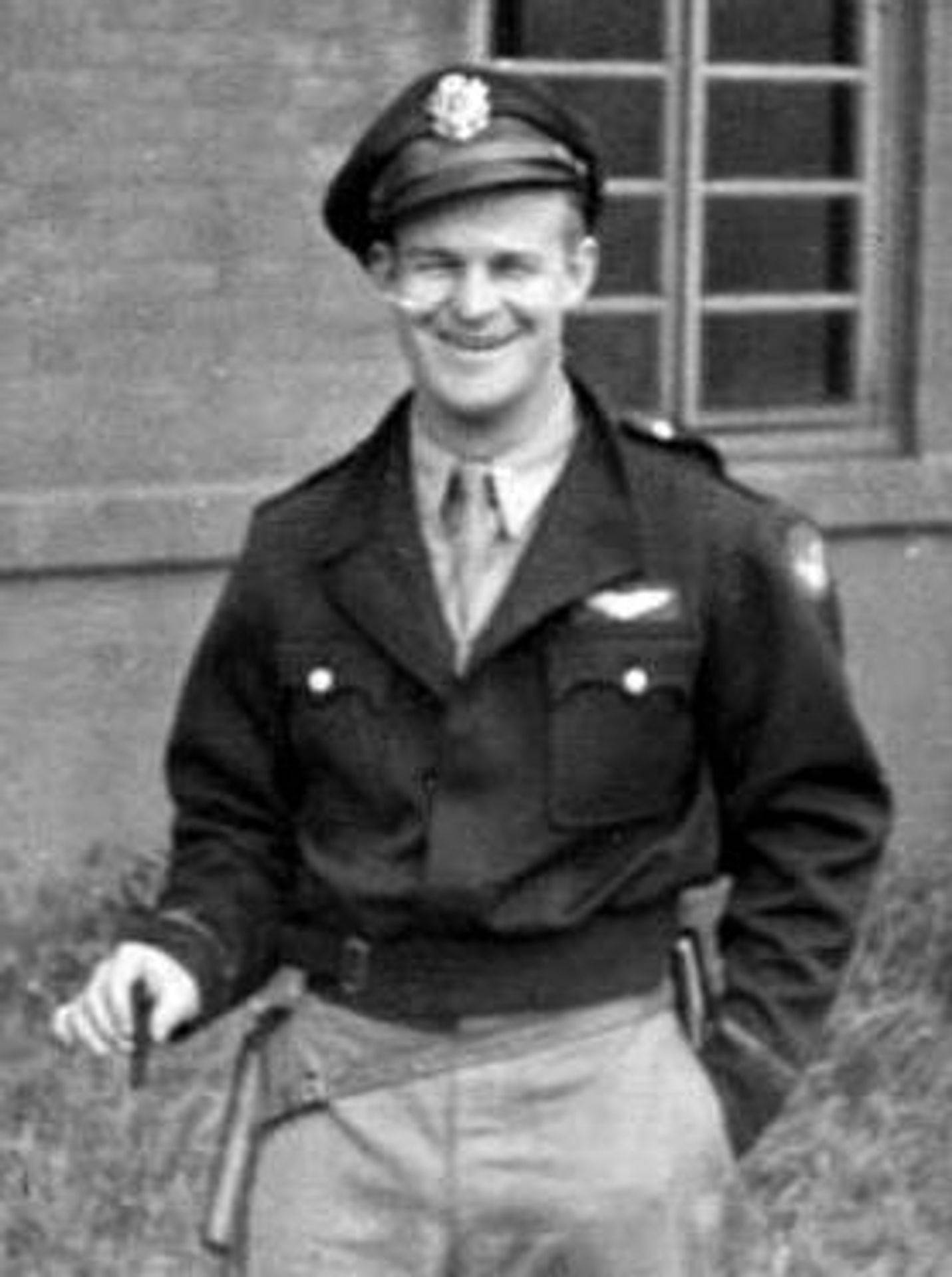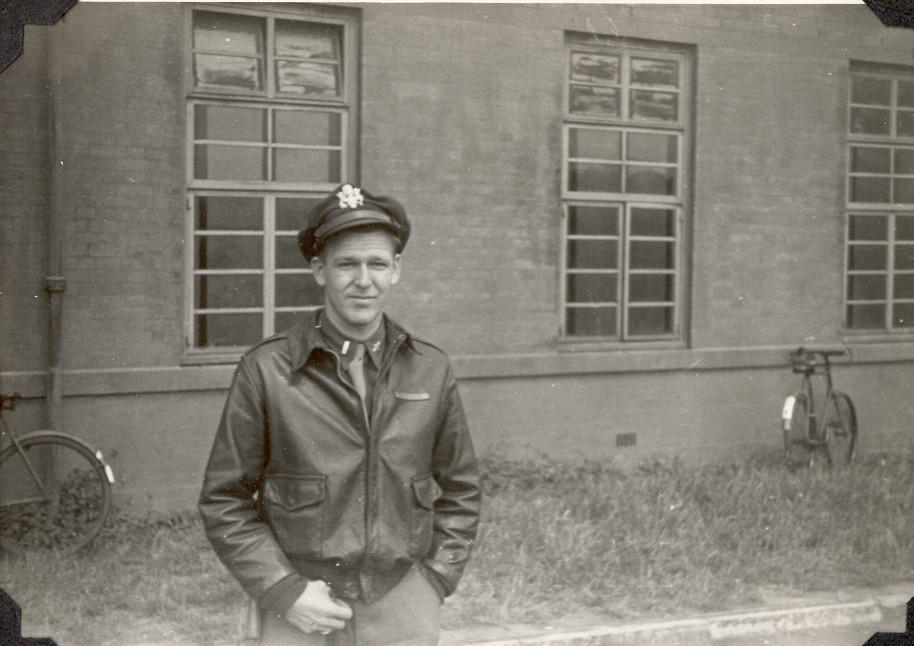Crew 31 – Assigned 753rd Squadron – October 21, 1943

(Photo: AFHRA)
Completed Tour
| Rank | Name | Serial # | Crew Position | Date | Status | Comments |
|---|---|---|---|---|---|---|
| 1Lt | Harley T Gaines | 0681380 | Pilot | Aug-44 | CT | Awards - Distinguished Flying Cross |
| 1Lt | Dana S Winters | 0748871 | Co-pilot | Sep-44 | CT | Original Crew member completed tour |
| 1Lt | John J Mucksavage | 0810169 | Navigator | Aug-44 | CT | Awards - Distinguished Flying Cross |
| 2Lt | Herbert E Crandall | 20232211 | Bombardier | Dec-43 | TRSF | Transferred to Pacific Theater |
| Sgt | George Wood | Radio Operator | Nov-43 | UNK | Tonopah Crew Photo - Crew #31 | |
| T/Sgt | Joseph M DiLaura | 32212463 | Flight Engineer | Aug-44 | CT | Awards - Distinguished Flying Cross |
| S/Sgt | Robert M Hall | 32761225 | Armorer-Gunner | Aug-44 | CT | Awards - Distinguished Flying Cross |
| S/Sgt | James E Hallingstead | 35543101 | Aerial Gunner | Aug-44 | CT | Awards - Distinguished Flying Cross |
| S/Sgt | Clarence C Daw | 14163539 | Top Turret Gunner | 06-Mar-44 | KIA | Shot down Berlin - McMains Crew |
| S/Sgt | Joseph Swidecki | 35520888 | Aerial Gunner/2E | 06-Oct-44 | CT | Trsf 70RD - Completed Tour |
The Gaines crew trained in Tonopah, NV in the fall/winter of 1943. They flew the Southern Ferry Route with the rest of the 458th in January 1944, arriving a bit later than many crews due to mechanical difficulties along the way. The exact date is not known, but it is assumed that bombardier, 2Lt Herbert E. Crandall was transferred at some point prior to the crew’s embarkation from the States. Crandall went on to serve in the Pacific Theater. The reason for his transfer is unknown. His place was taken by 2Lt Walter E Case.
According to a letter that co-pilot, Dana Winters wrote to a fellow 753rd Squadron pilot long after the war, radio-operator Sgt. George Wood was killed in Norwich. Nothing further is mentioned by Winters, and Wood’s name is not on the 458th list as a casualty. Neither does Wood’s name appear in the group records, save for the caption in the crew photo. The roster of gunners from April 1, 1944 lists Sgt (later T/Sgt) William J. Spulak as the radio operator assigned to Crew 31.
The crew flew their first combat mission on March 5, 1944 to Bordeaux, France. The next day, March 6th, was the first American raid on the German capitol of Berlin. Gaines and crew were stood down on this date, but S/Sgt Clarence C. Daw, ball turret gunner, flew as a replacement on 2Lt Jesse McMains crew. McMains was shot down (MACR 3349) and three, including Daw were killed in action. Daw’s place was taken by Sgt Valenti F. Yankowski. It is assumed that Yankowski flew his missions and completed a combat tour with this crew, as there is nothing in the records to indicate this.
According to formation plans and other operational records, Gaines’ crew flew a/c #735 (41-28735 S J4) on 18 of their 30+ missions. It is not known if this aircraft had a name or if any photos exist. The crew flew 19 missions in March, April, and May. On the April 8th raid on Brunswick, S/Sgt Robert M. Hall was credited with a fighter damaged.
At some point in August, Dana Winters, now flying as a first pilot, was injured and removed from flying status. He wrote, “At about my 24th mission I fell headlong into a machine gun emplacement near our briefing room at Horsham St. Faith (2:15A.M.). I had a bad knee cartilage from high school football and this stupid stunt managed to break the knee again. I was in the hospital at Wymondham for many weeks. This grounded me, but they wouldn’t send me home or give me a job on the base. I used my time to enter the London Royal Arts Academy to pursue water color. The war slowed and they finally sent me home.”
Missions – 1Lt Harley Gaines as Pilot
| Date | Target | 458th Msn | Pilot Msn | Serial | RCL | Sqdn | A/C Msn | A/C Name | Comments |
|---|---|---|---|---|---|---|---|---|---|
| 05-Mar-44 | BORDEAUX/MERIGNAC | 3 | 1 | 41-28735 | S | J4 | 1 | UNKNOWN 005 | |
| 08-Mar-44 | BERLIN/ERKNER | 5 | ABT | 41-28735 | -- | -- | -- | UNKNOWN 005 | ABORT |
| 15-Mar-44 | BRUNSWICK | 7 | 3 | 41-28735 | S | J4 | 2 | UNKNOWN 005 | |
| 16-Mar-44 | FRIEDRICHSHAFEN | 8 | ABT | 41-28735 | S | J4 | -- | UNKNOWN 005 | #2 ENG THROWING OIL |
| 18-Mar-44 | FRIEDRICHSHAFEN | 9 | 4 | 41-28705 | H | J4 | 8 | YE OLDE HELLGATE | |
| 22-Mar-44 | BERLIN | 11 | 5 | 41-29300 | M | J4 | 9 | LORELEI | |
| 23-Mar-44 | OSNABRUCK | 12 | 6 | 42-52392 | O | J4 | 7 | WABBIT TWACKS | |
| 05-Apr-44 | ST. POL-SIRACOURT | 16 | 7 | 41-29273 | Q | J4 | 12 | FLAK MAGNET | |
| 08-Apr-44 | BRUNSWICK/WAGGUM | 17 | 8 | 41-28735 | S | J4 | 7 | UNKNOWN 005 | |
| 09-Apr-44 | TUTOW A/F | 18 | NTO | 41-29276 | T | J4 | -- | URGIN VIRGIN/The ROTTEN SOCK | OXY LEAK WHILE TAXI |
| 10-Apr-44 | BOURGES A/F | 19 | 9 | 41-28735 | S | J4 | 8 | UNKNOWN 005 | |
| 12-Apr-44 | OSCHERSLEBEN | REC | ABT | 41-28735 | S | J4 | -- | UNKNOWN 005 | RECALL GAS LEAK RGT WING CAP |
| 13-Apr-44 | LECHFELD A/F | 21 | 10 | 41-28735 | S | J4 | 10 | UNKNOWN 005 | |
| 20-Apr-44 | SIRACOURT | 24 | 11 | 41-28735 | S | J4 | 12 | UNKNOWN 005 | |
| 24-Apr-44 | LEIPHEIM A/F | 26 | ABT | 41-28735 | S | J4 | -- | UNKNOWN 005 | GAS LEAK AROUND FILLER CAPS |
| 25-Apr-44 | MANNHEIM A/F | 27 | ABT | 41-28735 | S | J4 | -- | UNKNOWN 005 | #1, 3 ENG's ON FIRE |
| 26-Apr-44 | PADERBORN A/F | 28 | 12 | 41-28735 | S | J4 | 14 | UNKNOWN 005 | |
| 27-Apr-44 | BLAINVILLE-SUR-L'EAU M/Y | 30 | 13 | 41-28735 | S | J4 | 16 | UNKNOWN 005 | |
| 29-Apr-44 | BERLIN | 31 | 14 | 41-28735 | S | J4 | 17 | UNKNOWN 005 | R/O OXY LEAK - SORTIE |
| 04-May-44 | BRUNSWICK/WAGGUM | 34 | 15 | 41-28735 | S | J4 | 19 | UNKNOWN 005 | |
| 05-May-44 | SOTTEVAST | 35 | 16 | 41-28735 | S | J4 | 20 | UNKNOWN 005 | |
| 09-May-44 | ST. TROND | 38 | 17 | 41-28735 | S | J4 | 22 | UNKNOWN 005 | |
| 10-May-44 | DIEPHOLZ | REC | -- | 42-50320 | J | J4 | -- | UNKNOWN 018 | RECALL BEFORE EC |
| 11-May-44 | EPINAL | 39 | 18 | 41-29489 | I | J4 | 1 | UNKNOWN 014 | |
| 12-May-44 | BOHLEN | 40 | 19 | 41-28735 | S | J4 | 23 | UNKNOWN 005 | |
| 13-May-44 | TUTOW A/F | 41 | 20 | 41-28705 | H | J4 | 27 | YE OLDE HELLGATE | |
| 19-May-44 | BRUNSWICK | 42 | ABT | 41-28733 | P | J4 | -- | RHAPSODY IN JUNK | PILOT BECAME ILL AT ALT |
| 14-Jun-44 | 5 TARGETS | AZ06 | 21 | 42-110141 | U | J4 | 2 | BREEZY LADY / MARIE / SUPERMAN | |
| 15-Jun-44 | 3 RAILWAY BRIDGES | AZ07 | 22 | 42-110141 | U | J4 | 3 | BREEZY LADY / MARIE / SUPERMAN | |
| 24-Jun-44 | ST OMER | 78 | ABT | 44-40126 | D | Z5 | -- | SPITTEN KITTEN / SKY TRAMP | MSN #2 - BOMBARDIER SICK |
| 29-Jun-44 | ASCHERSLEBEN | 82 | ABT | 42-52457 | Q | 7V | -- | FINAL APPROACH | #4 SUPER CHGR SURGE |
| 07-Jul-44 | LUTZKENDORF | 86 | 23 | 42-100341 | A | J4 | 21 | SATAN'S MATE | |
| 16-Aug-44 | MAGDEBURG | 115 | 24 | 44-40285 | H | J4 | 29 | TABLE STUFF |
Missions – 1Lt Dana Winters as Pilot
| Date | Target | 458th Msn | Pilot Msn | Serial | RCL | Sqdn | A/C Msn | A/C Name | Comments |
|---|---|---|---|---|---|---|---|---|---|
| 02-Aug-44 | 3 NO BALLS | 101 | 1 | 44-40273 | T | J4 | 9 | HOWLING BANSHEE | *LDF |
| 03-Aug-44 | 2 NO BALLS | 102 | 2 | 44-40201 | N | J4 | 8 | SILVER CHIEF | |
| 05-Aug-44 | BRUNSWICK/WAGGUM | 105 | 3 | 44-40134 | R | J4 | 12 | UNKNOWN 039 | |
| 06-Aug-44 | HAMBURG | 106 | 4 | 44-40285 | H | J4 | 23 | TABLE STUFF | |
| 08-Aug-44 | CLASTRES | 108 | 5 | 44-40285 | H | J4 | 25 | TABLE STUFF | |
| 13-Aug-44 | LIEUREY | 112 | 6 | 44-40273 | T | J4 | 15 | HOWLING BANSHEE | |
| 14-Aug-44 | DOLE/TAVAUX | 113 | 7 | 44-40288 | S | J4 | 16 | BAD GIRL |
2Lt Dana S. Winters

Missing! – Missing?
It was Tuesday, January 25, 1944.
Finally, the months of training, double time and flight lines came to an abrupt halt. Bomber pilots were needed in England, and down came the decision. Only weeks after earning my wings as a fighter pilot at Luke Field, Arizona, it was decreed from that moment on, I was a multi-engine pilot (even if I didn’t know how to get into one of those things).
Yes, after more hurry-up training at Gowen Field, Boise, Idaho, and Tonopah, Nevada, it was time on that Tuesday to leave Hamilton Field north of San Francisco, and begin our extensive flight to somewhere in the British Isles.
Tearful goodbyes had been said. But the number two engine on our new B-24 didn’t want to go overseas. Its cowling tore itself loose and hurled its bulk down past the Golden Gate Bridge and into the cold waters of San Francisco Bay.
Orders directed our crew to join a flight of new crews at Palm Springs, a southern California desert community. It wasn’t to be today. We limped back to Hamilton Field and fidgeted for two days awaiting a new cowling. My wife, Virginia, was subjected to more goodbyes which she couldn’t deal with seriously.
The route we were to take was, of course, top secret. It was so secret that the leading American picture magazine traced our protected journey with a series of large photographs. The handful of new liberators left Palm Springs the next day, heading for Midland, Texas. We were all nervous and apprehensive of what was ahead for our flight.
Midland Airfield was devoted to training army guard dogs, thus it was a noisy dogs’ night for us. Our patch of bombers took off and made for West Palm Beach, Florida, the jumping-off place for departure from this continent.
The next day’s flight to Puerto Rico didn’t happen. That day we were given no reason for the stand-down. It was a stand-down which stretched to four days, still without reasons. On the fifth day our knot of planes went kiting south for San Juan, Puerto Rico. In the descent to the island, the number three engine started complaining. After eying the gauges, we feathered number three and landed with only three engines turning.
We followed a yellow-flagged jeep to an assigned transients roost. An immediate inspection disclosed a path of oil spraying out below number three. Later, we were told we needed parts for a supercharger on the engine. We were grounded. Parts had to be sent for.
Eleven days later, the engine fully repaired, we took off alone for South America. It was on this leg heading for Guyana that I learned what pain a plugged Eustachian tube can cause. A half-hour with the airport doctor provided me with new ears and a desire to continue living.
Next day we were off at dawn for Belem, a huge Brazilian city at the mouth of the Amazon. Here we caught up with a few Liberator stragglers waiting for orders to proceed.
It was the fifth waiting day at Belem before we were cleared for Fortaleza, a city on the protruding point of South America, closest to the African continent. At Fortaleza we loaded with extra gas tanks and were briefed about landing at Dakar. The Germans had recently been driven out of this city which then made possible a landing on huge rolls of steel mats spread out over desert sand. This had to be a strictly heads up maneuver. Landing off the strip could be fatal.
Twenty-six days had already been consumed on this over-the-Atlantic journey but we hadn’t begun to cross it yet. I wondered where the original five planes from Palm Springs were now.
In the briefing at Fortaleza, we were advised to keep all eyes peeled for submarines surfacing and lobbing flak at our crossing planes. We had no armor plate. There were no guns or ammunition on our plane. All of us had parachutes, but the Atlantic was wide in places, and a swim could be a long one.
We battled heavy winds and rain out of Fortaleza but Mucksavage, the navigator, hit Dakar on the nose. We showed eight minutes of normal flying time left in the tanks. Landing on steel nets was a brutal experience. The resulting screeching was like the Mormon Choir all singing a different song at the same time.
We spent a tired night in Dakar only to be awakened early the next morning. The early destination was to be Casablanca, but this had apparently been changed to Marrakech, Morocco.
This leg of our trip inspired terror in me. Nearly one hundred miles out of Marrakech, we saw up ahead a surging, ever-changing black cloud. None of the crew could tell what it was. As we neared, large splotches of blood appeared on the planes windshield.
Grasshoppers! Locusts! Cicadas or whatever. We took evasive action, diving steeply and banking hard to the left. Gaines and I had visions of those fat bugs wedging themselves into the engines’ air intakes.
Marrakech was still some distance away. The billowing insects yet posed a giant fence between our plane and the landing strip ahead. Directly below the giant rolling sand dunes of the Sahara seemed endless.
I don’t know how it happened. Either the wind shifted or the grasshoppers were on our side. The black death veered to one side, which allowed us to head straight into the pattern for the landing strip below. Swift contact with their tower was made and we landed far, far above average speed.
None of us knew that day we were to begin another of those long delays. We met crews who had started form Palm Springs more than two weeks after our departure. We learned that the last leg of flying would take us again out into the Atlantic, around Portugal and over England and Wales to Scotland. This trip was all the more dangerous because of unfriendly German planes and surfacing German submarines.
Marrakech was an interesting city, unlike Los Angeles. After two days of watching a heat-crazed Arab trying to jump-start his camel, we kept busy for five days more shuffling cards for a low ante poker game.
Air intakes were cleared of grasshoppers (which kids picked up off sidewalks and strung on coat hangers for food), and we waited for tail winds.
Winds and weather allowed a good take-off. Long hours later, we circled Prestwick, Scotland, a destination we had headed for thirty-six days ago. The following day, in an assigned plane, we took off for Horsham St. Faith, the British airdrome redesigned for bombers of the 458th. We circled the spire of the grand cathedral of Norwich, one of the tallest in England, and rolled to a final stop at the end of the runway. It was a strange feeling finally to be at the place where WWII was to begin for us.
Two hours later, I was put into shock. On the base operations board was a brief note flatly stating that the following crew members were listed as ”missing.” I cannot remember whether it said missing in action, or missing in no action. But there it was. I hoped to God they didn’t write Virginia. Thirty-seven days “missing” and we hadn’t even started.
What a war!
Appears in 2ADA Journal – Spring 1993
(Photo: Anne Zimmer)
2Lt Walter E. Case, Bombardier

Case took Herbert Crandall’s place after he was transferred to the Pacific
(Photo: Anne Zimmer)
